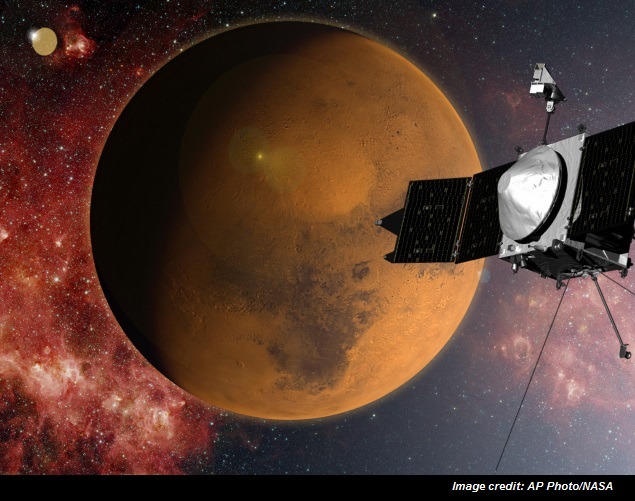- Home
- Science
- Science News
- Nasa's MAVEN Spacecraft Enters Mars Orbit
Nasa's MAVEN Spacecraft Enters Mars Orbit

"Based on observed navigation data, congratulations. MAVEN is now in orbit," said Dave Folta of Nasa's Goddard Space Flight Center just before 10:30pm (0230 GMT).
The unmanned orbiter has travelled more than 10 months and 442 million miles (711 million kilometres) to reach Mars for a first-of-its kind look at the planet's upper atmosphere.
The data from the Mars Atmosphere and Volatile Evolution (MAVEN) spacecraft aims to help scientists understand what happened to the water on Mars and the carbon dioxide in its atmosphere several billion years ago.
How Mars lost its atmosphere is one of science's biggest mysteries. The answers could shed light on the planet's potential to support life even if that was just microbial life - long ago.
MAVEN's findings are also expected to help add to knowledge of how humans could survive on a future visit to the Red Planet, perhaps as early as 2030.
"Mars is a cool place, but there is not much atmosphere," said John Clarke of the MAVEN science team.
"It is very cold, it is well below zero. The atmosphere is about half a percent of what we are breathing," he added.
"But we know that Mars could change and it was probably different in the past. There is a lot of evidence of flowing water on the surface from Mars' ancient history."
Mission begins
Next, MAVEN will enter a six-week phase for tests.
It will then begin a one-year mission of studying the gases in Mars's upper atmosphere and how it interacts with the sun and solar wind.
Much of MAVEN's year-long mission will be spent circling the planet 3,730 miles above the surface.
However, it will execute five deep dips to a distance of just 78 miles above the Martian landscape to get readings of the atmosphere at various levels.
Nasa is the world's most successful space agency at sending rovers and probes to Mars, and past missions have included the Viking 1 and 2 in 1975 and the Mars Reconnaissance Orbiter in 2005.
The US space agency's latest robotic vehicle, Curiosity, is exploring Gale Crater and Mount Sharp, looking for interesting rocks and returning data on whether the Martian environment shows evidence of a past ability to support life.
Later this week, an Indian spacecraft, the Mars Orbiter Mission, will be on course to reach Mars.
The unmanned MOM probe is set to enter Mars's orbit in the next few days after 10 months in space, marking India's first mission to the planet to search for evidence of life.
"We are not the only show that is happening on Mars this week," said Gary Napier, a spokesman for Lockheed Martin, during a Nasa television broadcast of the orbital insertion.
"Everyone at Nasa and its partners wishes that team all the best."
Get your daily dose of tech news, reviews, and insights, in under 80 characters on Gadgets 360 Turbo. Connect with fellow tech lovers on our Forum. Follow us on X, Facebook, WhatsApp, Threads and Google News for instant updates. Catch all the action on our YouTube channel.
Related Stories
- Samsung Galaxy Unpacked 2025
- ChatGPT
- Redmi Note 14 Pro+
- iPhone 16
- Apple Vision Pro
- Oneplus 12
- OnePlus Nord CE 3 Lite 5G
- iPhone 13
- Xiaomi 14 Pro
- Oppo Find N3
- Tecno Spark Go (2023)
- Realme V30
- Best Phones Under 25000
- Samsung Galaxy S24 Series
- Cryptocurrency
- iQoo 12
- Samsung Galaxy S24 Ultra
- Giottus
- Samsung Galaxy Z Flip 5
- Apple 'Scary Fast'
- Housefull 5
- GoPro Hero 12 Black Review
- Invincible Season 2
- JioGlass
- HD Ready TV
- Laptop Under 50000
- Smartwatch Under 10000
- Latest Mobile Phones
- Compare Phones
- Redmi Note 15 5G
- Redmi Note 15 Pro 5G
- Redmi Note 15 Pro+ 5G
- Lava Play Max
- Poco C85 5G
- Honor Magic 8 Lite
- Jolla Phone
- Realme P4x 5G
- Asus ProArt P16
- MacBook Pro 14-inch (M5, 2025)
- OnePlus Pad Go 2
- Poco Pad M1
- Just Corseca Skywatch Pro
- Honor Watch X5
- Acerpure Nitro Z Series 100-inch QLED TV
- Samsung 43 Inch LED Ultra HD (4K) Smart TV (UA43UE81AFULXL)
- Asus ROG Ally
- Nintendo Switch Lite
- Haier 1.6 Ton 5 Star Inverter Split AC (HSU19G-MZAID5BN-INV)
- Haier 1.6 Ton 5 Star Inverter Split AC (HSU19G-MZAIM5BN-INV)

















